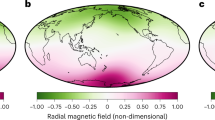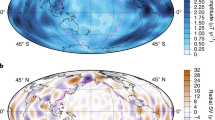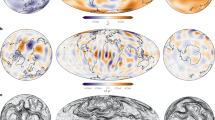Abstract
Earth’s magnetic field is generated by turbulent motion in its fluid outer core. Although the bulk of the outer core is vigorously convecting and well mixed, some seismic, geomagnetic and geodynamic evidence suggests that a global stably stratified layer exists at the top of Earth’s core. Such a layer would strongly influence thermal, chemical and momentum exchange across the core–mantle boundary and thus have important implications for the dynamics and evolution of the core. Here we argue that the relevant scenario is not global stratification, but rather regional stratification arising solely from the lateral variations in heat flux at the core–mantle boundary. Using our extensive suite of numerical simulations of the dynamics of the fluid core with heterogeneous core–mantle boundary heat flux, we predict that thermal regional inversion layers extend hundreds of kilometres into the core under anomalously hot regions of the lowermost mantle. Although the majority of the outermost core remains actively convecting, sufficiently large and strong regional inversion layers produce a one-dimensional temperature profile that mimics a globally stratified layer below the core–mantle boundary—an apparent thermal stratification despite the average heat flux across the core–mantle boundary being strongly superadiabatic.
This is a preview of subscription content, access via your institution
Access options
Access Nature and 54 other Nature Portfolio journals
Get Nature+, our best-value online-access subscription
$29.99 / 30 days
cancel any time
Subscribe to this journal
Receive 12 print issues and online access
$259.00 per year
only $21.58 per issue
Buy this article
- Purchase on Springer Link
- Instant access to full article PDF
Prices may be subject to local taxes which are calculated during checkout




Similar content being viewed by others
Data availability
The data that support the findings of this study are available from the corresponding author on request.
Code availability
The code used to model the core dynamics is described in Willis et al.55 and is available on request from the corresponding author.
References
Lay, T. & Young, C. J. The stably-stratified outermost core revisited. Geophys. Res. Lett. 17, 2001–2004 (1990).
Kaneshima, S. Array analyses of SmKS waves and the stratification of Earth’s outermost core. Phys. Earth Planet. Inter. 276, 234–246 (2018).
Helffrich, G. & Kaneshima, S. Outer-core compositional stratification from observed core wave speed profiles. Nature 468, 807–810 (2010).
Buffett, B. Geomagnetic fluctuations reveal stable stratification at the top of the Earth’s core. Nature 507, 484–487 (2014).
Buffett, B., Knezek, N. & Holme, R. Evidence for mac waves at the top of Earth’s core and implications for variations in length of day. Geophys. J. Int. 204, 1789–1800 (2016).
Buffett, B. A., Mound, J. & Jackson, A. Inversion of torsional oscillations for the structure and dynamics of Earth’s core. Geophys. J. Int. 177, 878–890 (2009).
Whaler, K. A. Does the whole of the Earth’s core convect? Nature 287, 528–530 (1980).
Gubbins, D. Geomagnetic constraints on stratification at the top of Earth’s core. Earth Planets Space 59, 661–664 (2007).
Amit, H. Can downwelling at the top of the Earth’s core be detected in the geomagnetic secular variation? Phys. Earth Planet. Inter. 229, 110–121 (2014).
Lesur, V., Whaler, K. & Wardinski, I. Are geomagnetic data consistent with stably stratified flow at the core-mantle boundary? Geophys. J. Int. 201, 929–946 (2015).
Alexandrakis, C. & Eaton, D. W. Precise seismic-wave velocity atop Earth’s core: no evidence for outer-core stratification. Phys. Earth Planet. Inter. 180, 59–65 (2010).
Irving, J. C. E., Cottaar, S. & Lekić, V. Seismically determined elastic parameters for Earth’s outer core. Sci. Adv. 4, 1–9 (2018).
Lister, J. R. & Buffett, B. A. Stratification of the outer core at the core-mantle boundary. Phys. Earth Planet. Inter. 105, 5–19 (1998).
Braginsky, S. I. Dynamics of the stably stratified ocean at the top of the core. Phys. Earth Planet. Inter. 111, 21–34 (1999).
Christensen, U. R. & Wicht, J. Models of magnetic field generation in partly stable planetary cores: applications to Mercury and Saturn. Icarus 196, 16–34 (2008).
Olson, P., Landeau, M. & Reynolds, E. Dynamo tests for stratification below the core-mantle boundary. Phys. Earth Planet. Inter. 271, 1–18 (2017).
Jones, C. A. Planetary magnetic fields and fluid dynamos. Annu. Rev. Fluid Mech. 43, 583–614 (2011).
Gubbins, D., Alfè, D., Davies, C. & Pozzo, M. On core convection and the geodynamo: effects of high electrical and thermal conductivity. Phys. Earth Planet. Inter. 247, 56–64 (2015).
Davies, C., Pozzo, M., Gubbins, D. & Alfè, D. Constraints from material properties on the dynamics and evolution of Earth’s core. Nat. Geosci. 8, 678–685 (2015).
Gubbins, D. & Davies, C. J. The stratified layer at the core-mantle boundary caused by barodiffusion of oxygen, sulphur and silicon. Phys. Earth Planet. Inter. 215, 21–28 (2013).
Buffett, B. A. & Seagle, C. T. Stratification of the top of the core due to chemical interactions with the mantle. J. Geophys. Res. 115, B04407 (2010).
Landeau, M., Olson, P., Deguen, R. & Hirsh, B. H. Core merging and stratification following giant impact. Nat. Geosci. 9, 786–789 (2016).
Jacobson, S. A., Rubie, D. C., Hernlund, J., Morbidelli, A. & Nakajima, M. Formation, stratification, and mixing of the cores of Earth and Venus. Earth Planet. Sci. Lett. 474, 375–386 (2017).
Lister, J. R. Thermal winds forced by inhomogeneous boundary conditions in rotating, stratified, hydromagnetic fluid. J. Fluid Mech. 505, 163–178 (2004).
Nakagawa, T. & Tackley, P. J. Lateral variations in CMB heat flux and deep mantle seismic velocity caused by a thermal–chemical-phase boundary layer in 3D spherical convection. Earth Planet. Sci. Lett. 271, 348–358 (2008).
Stackhouse, S., Stixrude, L. & Karki, B. B. First-principles calculations of the lattice thermal conductivity of the lower mantle. Earth Planet. Sci. Lett. 427, 11–17 (2015).
Olson, P., Deguen, R., Rudolph, M. L. & Zhong, S. Core evolution driven by mantle global circulation. Phys. Earth Planet. Inter. 243, 44–55 (2015).
Gibbons, S. J., Gubbins, D. & Zhang, K. Convection in rotating spherical fluid shells with inhomogeneous heat flux at the outer boundary. Geophys. Astrophys. Fluid Dynam. 101, 347–370 (2007).
Davies, C. J., Gubbins, D. & Jimack, P. K. Convection in a rapidly rotating spherical shell with an imposed laterally varying thermal boundary condition. J. Fluid Mech. 641, 335–358 (2009).
Dietrich, W., Hori, K. & Wicht, J. Core flows and heat transfer induced by inhomogeneous cooling with sub- and supercritical convection. Phys. Earth Planet. Inter. 251, 36–51 (2016).
Mound, J. E. & Davies, C. J. Heat transfer in rapidly rotating convection with heterogeneous thermal boundary conditions. J. Fluid Mech. 828, 601–629 (2017).
Sreenivasan, B. & Gubbins, D. Dynamos with weakly convecting outer layers: implications for core-mantle boundary interaction. Geophys. Astrophys. Fluid Dynam. 102, 395–407 (2008).
Sahoo, S., Sreenivasan, B. & Amit, H. Dynamos driven by weak thermal convection and heterogeneous outer boundary heat flux. Phys. Earth Planet. Inter. 250, 35–45 (2016).
Olson, P., Landeau, M. & Reynolds, E. Outer core stratification from the high latitude structure of the geomagnetic field. Front. Earth Sci. 6, 1–13 (2018).
Christensen, U. R. Geodynamo models with a stable layer and heterogeneous heat flow at the top of the core. Geophys. J. Int. 215, 1338–1351 (2018).
Masters, G., Johnson, S., Laske, G. & Bolton, H. A shear-velocity model of the mantle. Phil. Trans. R. Soc. A 354, 1385–1411 (1996).
Hernlund, J. W. & McNamara, A. K. in Mantle Dynamics (ed. Bercovici, D.) 461–519 (Elsevier, 2015).
Gastine, T., Wicht, J. & Aubert, J. Scaling regimes in spherical shell rotating convection. J. Fluid Mech. 808, 690–732 (2016).
Calkins, M. A. et al. The asymptotic equivalence of fixed heat flux and fixed temperature thermal boundary conditions for rapidly rotating convection. J. Fluid Mech. 784, R2 (2015).
Zhang, N. & Zhong, S. Heat fluxes at the Earth’s surface and core–mantle boundary since Pangea formation and their implications for the geomagnetic superchrons. Earth Planet. Sci. Lett. 306, 205–216 (2011).
Glatzmaier, G. A., Coe, R. S., Hongre, L. & Roberts, P. H. The role of the Earth’s mantle in controlling the frequency of geomagnetic reversals. Nature 401, 885–890 (1999).
Olson, P., Deguen, R., Hinnov, L. A. & Zhong, S. Controls on geomagnetic reversals and core evolution by mantle convection in the Phanerozoic. Phys. Earth Planet. Inter. 214, 87–103 (2013).
Aubert, J., Amit, H., Hulot, G. & Olson, P. Thermochemical flows couple the Earth’s inner core growth to mantle heterogeneity. Nature 454, 758–761 (2008).
Gubbins, D., Sreenivasan, B., Mound, J. & Rost, S. Melting of the Earth’s inner core. Nature 473, 361–363 (2011).
Ichikawa, H., Tsuchiya, T. & Tange, Y. The P-V-T equation of state and thermodynamic properties of liquid iron. J. Geophys. Res. 119, 240–252 (2014).
Komabayashi, T. Thermodynamics of melting relations in the system Fe-FeO at high pressure: implications for oxygen in the Earth's core. J. Geophys. Res. Solid Earth 119, 4164–4177 (2014).
Brodholt, J. & Badro, J. Composition of the low seismic velocity E’ layer at the top of Earth’s core. Geophys. Res. Lett. 44, 8303–8310 (2017).
Olson, P. & Christensen, U. R. The time-averaged magnetic field in numerical dynamos with non-uniform boundary heat flow. Geophys. J. Int. 151, 809–823 (2002).
Aubert, J., Finlay, C. C. & Fournier, A. Bottom-up control of geomagnetic secular variation by the Earth’s inner core. Nature 502, 219–223 (2013).
Mound, J., Davies, C. & Silva, L. Inner core translation and the hemispheric balance of the geomagnetic field. Earth Planet. Sci. Lett. 424, 148–157 (2015).
Finlay, C. C., Olsen, N., Kotsiaros, S., Gillet, N. & Tøffner-Clausen, L. Recent geomagnetic secular variation from Swarm and ground observatories as estimated in the CHAOS-6 geomagnetic field model. Earth, Planets Space 68, 112 (2016).
Alboussière, T., Deguen, R. & Melzani, M. Melting-induced stratification above the Earth’s inner core due to convective translation. Nature 466, 744–747 (2010).
Monnereau, M., Calvet, M., Margerin, L. & Souriau, A. Lopsided growth of Earth’s inner core. Science 328, 1014–1017 (2010).
Davies, C. J., Silva, L. & Mound, J. On the influence of a translating inner core in models of outer core convection. Phys. Earth Planet. Inter. 214, 104–114 (2013).
Willis, A. P., Sreenivasan, B. & Gubbins, D. Thermal core–mantle interaction: exploring regimes for ‘locked’ dynamo action. Phys. Earth Planet. Inter. 165, 83–92 (2007).
Dziewonski, A. M. & Anderson, D. L. Preliminary reference Earth model. Phys. Earth Planet. Inter. 25, 297–356 (1981).
Konôpková, Z., McWilliams, R. S., Gómez-Pérez, N. & Goncharov, A. F. Direct measurement of thermal conductivity in solid iron at planetary core conditions. Nature 534, 99–101 (2016).
Nimmo, F. in Core Dynamics (ed. Olson, P.) 27–55 (Elsevier, 2015).
Sumita, I. & Olson, P. Rotating thermal convection experiments in a hemispherical shell with heterogeneous boundary heat flux: implications for the Earth’s core. J. Geophys. Res. 107, 2169 (2002).
Childs, H. et al. in High Performance Visualization (eds Bethel, E. W. et al.) 357–372 (Chapman and Hall, 2012).
Hunter, J. D. Matplotlib: A 2D graphics environment. Comput. Sci. Eng. 9, 90–95 (2007).
Waskom, M. et al. mwaskom/seaborn v0.8.0 (Zenodo, 2017); https://doi.org/10.5281/zenodo.824567
Acknowledgements
C.D. is supported by a Natural Environment Research Council Independent Research Fellowship (NE/L011328/1). J.A. is supported by the NSF Geophysics programme via award no. EAR-1853196. This work used the ARCHER UK National Supercomputing Service (http://www.archer.ac.uk) and ARC2, part of the High Performance Computing facilities at the University of Leeds, UK.
Author information
Authors and Affiliations
Contributions
All authors discussed and developed the central ideas and contributed to the writing of the manuscript. J.M. and C.D. carried out the numerical modelling and analysis.
Corresponding author
Ethics declarations
Competing interests
The authors declare no competing interests.
Additional information
Publisher’s note: Springer Nature remains neutral with regard to jurisdictional claims in published maps and institutional affiliations.
Supplementary information
Supplementary Video 1
Equatorial slices (viewed from above; Pacific to the left, Africa to the right) of the thermal structure in the simulation with a tomographic pattern of CMB heat flux presented in Fig. 1. Left, temperature field. Right, radial gradient of temperature.
Supplementary Video 2
Equatorial slices (viewed from above; Pacific to the left, Africa to the right) of the thermal structure in the simulation with a hemispheric pattern of CMB heat flux presented in Supplementary Fig. 1. Left, temperature field. Right, radial gradient of temperature.
Rights and permissions
About this article
Cite this article
Mound, J., Davies, C., Rost, S. et al. Regional stratification at the top of Earth's core due to core–mantle boundary heat flux variations. Nat. Geosci. 12, 575–580 (2019). https://doi.org/10.1038/s41561-019-0381-z
Received:
Accepted:
Published:
Issue Date:
DOI: https://doi.org/10.1038/s41561-019-0381-z
This article is cited by
-
Longitudinal structure of Earth’s magnetic field controlled by lower mantle heat flow
Nature Geoscience (2023)
-
A hydrogen-enriched layer in the topmost outer core sourced from deeply subducted water
Nature Geoscience (2023)
-
Gyres, jets and waves in the Earth’s core
Nature Reviews Earth & Environment (2023)
-
Kilometer-scale structure on the core–mantle boundary near Hawaii
Nature Communications (2022)
-
Rapid geomagnetic changes inferred from Earth observations and numerical simulations
Nature Communications (2020)



